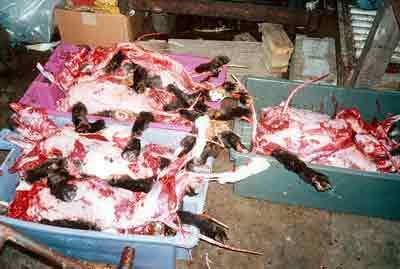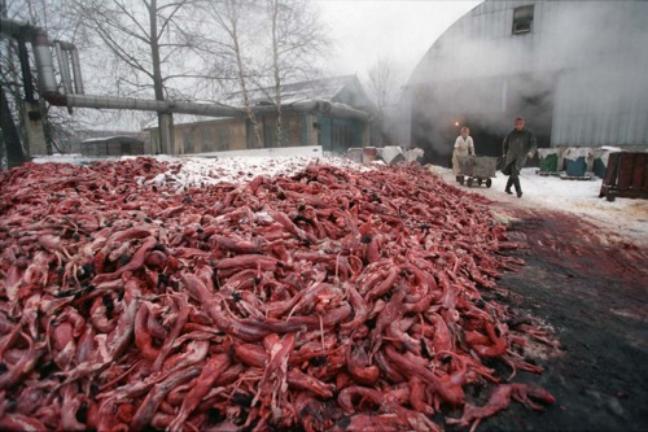Translate This Page
The conditions under which animals are kept are the same throughout the world. Long rows of barren wire cages in open sided sheds house the animals that are fed with dollops of paste placed on the cage tops. Water is supplied by hose and nipple. A typical mink cage would measure 70cm long by 40 wide and 45 high. Its size is based more on the length of a persons arm than the biological needs of the species. A cage for two Arctic foxes would typically measure 110 cms square.
Over 50 million mink (Mustela vison) and 7 million fox (mostly Arctic fox - Alopex lagopus) are bred each year to meet the world demand for their skins. More than half the world’s mink are bred in Scandinavia where there are more than 10,000 fur factory farms. Two thirds of all fox bred for fur come from Finland.
Although mink and Arctic fox are the main species bred in fur factory farms others include red fox, sable, coypu, and chinchilla. US breeders are experimenting with beaver, lynx, raccoon, wolverine and coyote whilst in Eastern Europe even domestic cats are being reared for their skins.
Mink and fox are unique amongst farm animals. They are highly inquisitive and intelligent carnivorous predators. Agricultural legislation has been drawn up for herd or flock animals like cows, sheep or hens and so is inappropriate for fox and mink.
In 1989 the British Farm Animal Welfare Council described mink and fox as ‘essentially wild animals’ and expressed its disapproval of their farming stating that ‘the systems employed in the farming of mink and fox do not satisfy some of the most basic criteria ‘for protecting the welfare of farm animals’. In November 2000 the Government recognised this and banned fur farming in England and Wales. The Fur Farming (Prohibition) Act 2000 was introduced on moral grounds. Scotland and Northern Ireland introduced their own legislation shortly after meaning that fur farming is banned in the UK.
In the wild, mink defend and patrol riverbank territories of up to 2.5 miles in length whilst Arctic fox range over vast areas of up to 15,000 acres.
Mink are semi-aquatic but in the fur factory farm have no access to water in which to swim. Experiments have shown, however, that captive mink will go to enormous efforts to reach water to swim in.
Fur factory farms follow a regular calendar. Animals are mated in February, give birth in May, weaned 6-7 weeks later and each year’s offspring are killed in November at the age of just 7 months.
Animals kept in fur factory farms show clear signs of stress. They perform stereotyped behaviour, mutilate themselves, sucking or biting their own tails. Some even resort to cannibalism.
The killing of animals on fur factory farms is carried out immediately after their first winter’s moult when their fur is at its best and any defects have disappeared. Slaughter methods include gassing (using vehicle exhaust), neck breaking, lethal injection and electricution.
During genital electrocution, the killer attaches an alligator clamp to the animal's ear and another to her labia and flips a switch, or plugs the wires into the wall socket, sending a jolt of electricity through her skin down the length of her body. She jerks and stiffens. But, according to biologist, Leslie Gerstenfield-Press, although the electrical current stops the heart, it does not kill her; in many cases the animals remain conscious. The electrical current causes unbearable muscle pain, at the same time working as a paralyzing agent, preventing the victim from screaming or fleeing. A chinchilla farmer who uses genital electrocution told investigators that he leaves the clips on "for one or two minutes" to make sure the heart doesn't start up again, but sometimes animals revive-those who do remember the pain.Also anal electricution is used.
Prior to the ban on fur farming, in the UK no qualifications or training were required for those carrying out the killing and this is the same in most countries.
Some countries have banned fur farming for some or all species. Here is a summary of fur farming legislation around the world:
Austria: has an outright ban on fur farming throughout the entire nation since 2004.
Croatia: In December 2006, the Croatian government introduced a new Animal Protection Act that bans fur farming. The legislation came into force on January 1, 2007 and the ban is subject to a 10 year phase out period.
Denmark: A ban on fox farming was introduced in 2009 with a phase-out period until 2017 for most farmers, and until 2023 for the two fur farmers for whom fox farming is their main income. Welfare regulations for mink farms remain weak.
Ireland: In October 2009, the government pledged to ban fur farming with a phase out period of 3 years, after an initiative from the Green Party. This has yet to become law.
Italy: Rabbit and Chinchilla are required by law to be kept in condidions that make farming them uneconomic.
The Netherlands: Became the first country in the world to ban fox farming in 1995, with a phase out period of 10 years. Chinchilla farming was prohibited in 1997. A bill based on ethical arguments to ban mink farming has recently passed in the lower house of parliament. This despite the fact that the Netherlands is the world’s third largest producer of mink pelts. The next step is for the senate vote on the ban.
New Zealand: Allows fur farming of ferrets (between 2 and 5 farms exist in the entire country), but prohibits the import of mink. This means that effectively mink farming is banned in New Zealand.
Sweden: In 1995, Sweden passed an amendment to the Animal Protection Ordinance that required that fox be kept in such a way that they can be active, dig and socialize with other fox. Fox farming is no longer economically viable in Sweden and since 2001, fox farming is no longer carried out there.
Switzerland: The farming of fur animals is prevented by legislation which only allows their keeping under what are effectively zoo conditions. Thus, there are no fur farms in Switzerland.
United Kingdom: Under the Fur Farming (Prohibition) Act of 2000, England and Wales banned fur farming completely. All fur farms in England and Wales had to be shut down by January 1, 2003. Despite having no fur farms, Northern Ireland and Scotland both banned fur farming shortly afterwards. There are now no fur farms anywhere in the U.K.
U.S.A.: There is no federal law regulating the keeping or killing of cage-raised fur-bearing animals. No states have banned fur farming, but some states prohibit keeping foxes in captivity because of concerns about disease transmission to native wildlife. California has housing requirements for mink and fox that make fur farming of these species cost prohibitive. Wisconsin and Utah are currently the two top fur farming states.
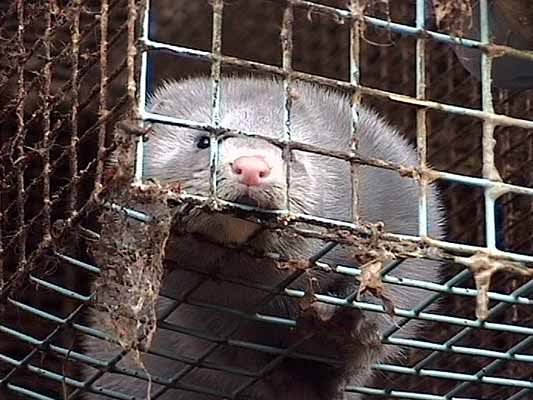
No regulations govern fur farms in China, which is the world's largest fur exporter, supplying more than half of the finished fur garments imported for sale in the United States. Foxes, minks, rabbits, dogs, cats, and other animals pace and shiver in outdoor wire cages, with no shelter from driving rain, freezing nights, or the scorching sun.
Mother animals, who are driven crazy from rough handling and intense confinement and have nowhere to hide while giving birth, often kill their babies after delivering litters. Disease and injuries are widespread, and animals suffering from anxiety-induced psychosis chew on their own limbs and throw themselves repeatedly against the cage bars.
Before they are skinned, animals are yanked from their cages, thrown to the ground, and bludgeoned. Undercover investigators from Swiss Animal Protection/EAST International found that many animals are still alive and struggling desperately when workers flip them onto their backs or hang them up by their legs or tails to skin them.
When they begin to cut the skin and fur from an animal's leg, the free limbs kick and writhe. Workers stomp on the necks and heads of animals who struggle too hard to allow a clean cut.
When the fur is finally peeled off over the animals' heads, their hairless, bloody bodies are thrown onto a pile of those who have gone before them. Some are still alive, breathing in ragged gasps and blinking slowly. Some of the animals' hearts are still beating five to 10 minutes after they are skinned. One investigator recorded a skinned raccoon dog on the heap of carcasses who had enough strength to lift his bloodied head and stare into the camera.
When investigators went into another animal market in southern China, they were horrified to find dogs and cats being bludgeoned, hanged, bled to death, and strangled with wire nooses so that their fur could be turned into trim and trinkets.
They found cats and dogs languishing in tiny cages, visibly exhausted. Some had been on the road for days, transported in flimsy wire-mesh cages with no food or water.
Twenty cats were forced into a single cage. Because of the cross-country transport in such deplorable conditions, the investigators were able to see dogs and cats with open wounds, dying cats and dogs inside the cages, and dead cats on top of the cages. Some animals were lethargic or frightened, and others were fighting with each other, driven insane from confinement and exposure.
Up to 8,000 animals are loaded onto each truck, with cages stacked on top of each other. Cages containing live animals are commonly tossed from the tops of the trucks onto the ground 10 feet below, shattering the legs of the animals inside them. Many of the animals still had collars on, a sign that they were once someone's beloved companion, stolen to be made into a fur coat.
This fur from China is often deliberately mislabeled as fur from other species and is exported to countries throughout the world to be sold to unsuspecting customers in retail stores. Since China supplies more than half of the finished fur garments imported for sale in the United States and since dog and cat fur is often mislabeled, if you're buying fur, there's no way to tell whose skin you're wearing, including that of a dog or cat
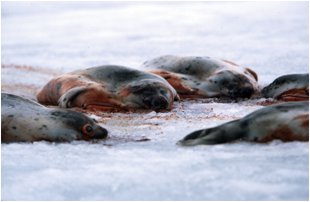 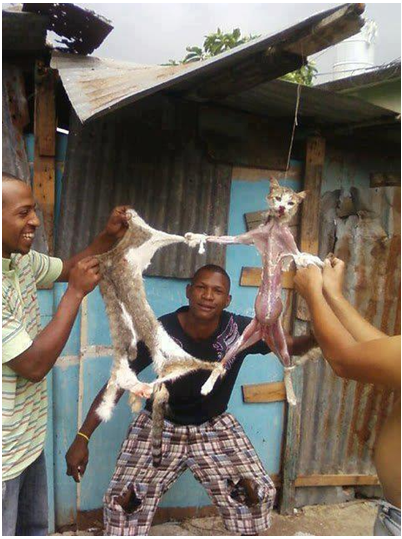 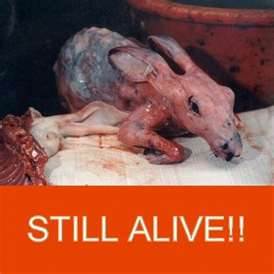 |  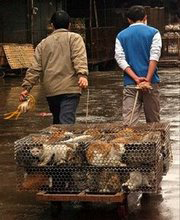 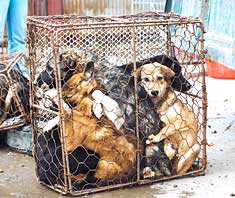 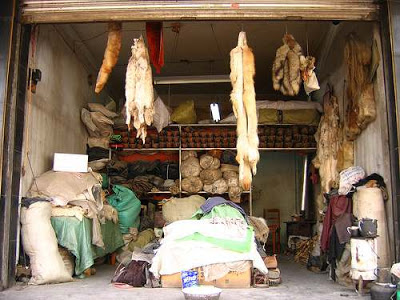 |
